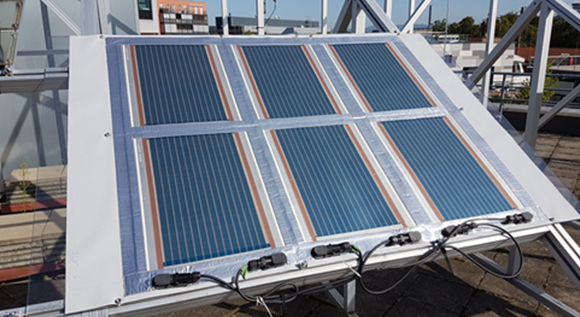Floating solar cells
Researchers on the German energy transition are developing pieces of floating film fitted with organic solar cells. These sheets can protect water reservoirs and generate electricity sustainably at the same time.
 © Fraunhofer ISE
© Fraunhofer ISE
Ultra-slim organic solar cells are up to 1,000 times thinner than a human hair and the great new hope vested in the research project entitled 'Organic photovoltaics for covering water reservoirs' (H2OPV). In this project, experts are investigating how pieces of environmentally friendly film integrated with these cells can be used to advance the energy transition. The idea is to use the pieces of floating film to protect water reservoirs from pollution and evaporation and generate electricity at the same time.
The first practical tests are already under way at the Freiburg Fraunhofer Institute for Solar Energy Systems (ISE). As part of these tests, a strip of solar film measuring 50 meters long and 36 centimetres wide was coated and lots of 30 by 40-centimeter individual modules connected to one another. Solar cells that are made of organic substances rather than silicon have many advantages, so the researchers involved hope to use this apparatus to gain important insights that will enable such modules to be produced using industry-based methods in the future.
Flexible materials for diverse applications
Depending on the production process, organic solar cells can be flexibly bent and – according to expert assessment – can be manufactured more cheaply on an industrial scale than conventional photovoltaic modules. They work based on the use of semiconductor materials that convert the energy of the sun's rays into electricity. In organic photovoltaics, the semiconductor material used in the solar cells consists of carbon compounds. In conventional solar cells, the semiconductor is usually made of crystalline silicon, which is a sturdy, inflexible material. Organic photovoltaics therefore offers many new possibilities as the semi-conductor material can be applied in thin, flexible layers on flexible films or other flexible materials.
The lifetime of the cells and their efficiency (the proportion of solar radiation that can be converted into electricity) is still not comparable to that of crystalline silicon solar cells. But the speed at which such materials are being developed today is high. The researchers are therefore confident that there will soon be significant progress made in raising the efficiency of their modules. The project partners are already working on new organic semiconductor materials which it is hoped will be more efficient than the existing ones but just as durable. The target is for them to be able to last for at least a decade.
In a first step, the researchers are focusing on the use of the films as a floating photovoltaic system which is already far ahead of its relatives. It can be used as an airtight cover for water reservoirs in order to reduce pollution and evaporation. This could be of particular interest to countries that have strong solar radiation and high temperatures. Not even algae is able to survive underneath the cover film. This means that the water does not need any chemicals to be released into it, nor does it require the energy-intensive addition of oxygen to be pumped in. Transporting the films and installing them is also easy, all of which saves energy and costs.
Photovoltaic technology that is especially environmentally friendly
Project manager Markus Gnass has long had many other areas of application in mind as well. He believes that the strips of tarpaulin could also be used to cover flat roofs. 'The solar cells would then already be integrated into the covering and no further installation of photovoltaic modules would be needed,' Mr Gnass explains. He is coordinating the joint organic solar cell protect on behalf of ContiTech Elastomer-Beschichtungen GmbH.
In principle, the thin and sturdy strips of tarpaulin can be put to good use wherever something needs to be covered. They could be used, for example, on greenhouses which have a high energy requirement, or on landfills, which will then be upgraded. Mr Gnass also believes that they could be used in traffic, for example as tarpaulin for trucks. In order for their use on vehicles to be economical, the efficiency and effectiveness would have to be much higher, he says.
There is still some way to go, but the project partners are already certain that organic photovoltaics has the potential to become the most environmentally friendly photovoltaic technology. The semiconductor does not involve the use of any heavy metals and the material used has a good environmental footprint. It can be produced using comparatively little energy and requires little material resources due to the extreme thinness of the layers. The Federal Ministry for Economic Affairs and Energy is providing approximately 2.5 million euros in funding for the H2OPV research project.

